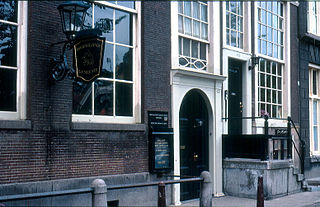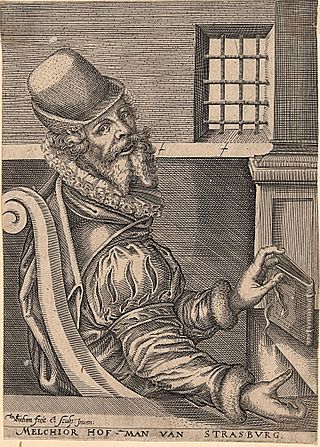Related Research Articles
Anabaptism is a Christian movement which traces its origins to the Radical Reformation in the 16th century. Anabaptists believe that baptism is valid only when candidates freely confess their faith in Christ and request to be baptized. Commonly referred to as believer's baptism, it is opposed to baptism of infants, who are not able to make a conscious decision to be baptized.

Mennonites are a group of Anabaptist Christian communities tracing their roots to the epoch of the Radical Reformation. The name Mennonites is derived from the cleric Menno Simons (1496–1561) of Friesland, part of the Holy Roman Empire, present day Netherlands. Menno Simons became a prominent leader within the wider Anabaptist movement and was a contemporary of Martin Luther (1483–1546) and Philip Melanchthon (1497-1560). Through his writings about the Reformation Simons articulated and formalized the teachings of earlier Swiss Anabaptist founders as well as early teachings of the Mennonites founded on the belief in both the mission and ministry of Jesus. Formal Mennonite beliefs were codified in the Dordrecht Confession of Faith (1632), which affirmed "the baptism of believers only, the washing of the feet as a symbol of servanthood, church discipline, the shunning of the excommunicated, the non-swearing of oaths, marriage within the same church", nonresistance, and in general, more emphasis on "true Christianity" involving "being Christian and obeying Christ" as they interpret it from the Holy Bible.

Menno Simons was a Roman Catholic priest from the Friesland region of the Low Countries who was excommunicated from the Catholic Church and became an influential Anabaptist religious leader. Simons was a contemporary of the Protestant Reformers and it is from his name that his followers became known as Mennonites.

The Mennonite Church in the Netherlands, or Algemene Doopsgezinde Sociëteit, is a body of Mennonite Christians in the Netherlands. The Mennonites are named for Menno Simons (1496–1561), a Dutch Roman Catholic priest from the Province of Friesland who converted to Anabaptism around 1536. He was re-baptized as an adult in 1537 and became part of the Dutch Anabaptist movement.
Pilgram Marpeck, also Pilgram Marbeck or Pilgrim Marpeck, was an important Anabaptist leader in southern Germany in the 16th century.

The Münster rebellion was an attempt by radical Anabaptists to establish a communal sectarian government in the German city of Münster – then under the large Prince-Bishopric of Münster in the Holy Roman Empire.

Melchior Hoffman was a German Anabaptist, radical lay preacher and reformer in northern Europe. He began his career as an outspoken proponent of Lutheranism but evolved his own theological voice influenced by late medieval mysticism, Joachimite apocalypticism, and the Anabaptist movement. He is credited with introducing Anabaptism to the Low Countries.

Jacob Isaackszoon van Ruisdael was a Dutch painter, draughtsman, and etcher. He is generally considered the pre-eminent landscape painter of the Dutch Golden Age, a period of great wealth and cultural achievement when Dutch painting became highly popular.

Jan Matthys was a charismatic Anabaptist leader of the Münster Rebellion, regarded by his followers as a prophet.

David Joris was an important Anabaptist leader in the Netherlands before 1540.
The Radical Reformation represented a response to perceived corruption both in the Catholic Church and in the expanding Magisterial Protestant movement led by Martin Luther and many others. Beginning in Germany and Switzerland in the 16th century, the Radical Reformation gave birth to many radical Protestant groups throughout Europe. The term covers Radical Reformers like Thomas Müntzer and Andreas Karlstadt, the Zwickau prophets, and Anabaptist groups like the Hutterites and the Mennonites.

The Zuiderhofje is a hofje in Haarlem, Netherlands.
Menno is a Dutch masculine given name of Old Frisian origin. It was made popular by the influential Frisian religious reformer Menno Simons, and the name was spread by his followers, the Mennonites.

Pieter Teyler van der Hulst was a wealthy Dutch Mennonite merchant and banker, who died childless, leaving a legacy of two million florins to the pursuit of religion, arts and science in his hometown, that led to the formation of Teyler's Museum. This was not the value of his entire estate. He also founded Teylers Hofje in his name, and made important donations to individuals in the Mennonite community.

The Mennonites in Bolivia are among the most traditional and conservative of all Mennonite denominations in Spaniard America. They are mostly Russian Mennonites of Frisian, Flemish, and Prussian descent. As of 2013, there were about 70,000 Mennonites living in Bolivia; that population has grown to around 150,000 as of 2023.
Vistula delta Mennonites were a historic Mennonite community, established in the mid-16th century in the Vistula river delta in Poland. It originated from the Netherlands and present-day northern Germany. The Mennonite community played an important role in the drainage and cultivation of the Vistula delta and the trade relations with the Netherlands. In the late 18th century a significant number of Mennonites emigrated further and formed the nucleus of the Mennonite settlements in Russia, while many remained in the region after the annexation of the region by Prussia in the Partitions of Poland. With the end of World War II and the flight and expulsion of Germans the Mennonite settlements in the Vistula delta ceased to exist.
Jacob Salomonsz. van Ruysdael, was a Dutch Golden Age landscape painter who was the son of Salomon van Ruysdael and the cousin of the more famous Jacob Isaakszoon van Ruisdael.

Klaas van der Horst was a Dutch Mennonite teacher and minister.

View of Haarlem with Bleaching Fields is an oil on canvas painting by Dutch landscape painter Jacob van Ruisdael. It is an example of Dutch Golden Age painting and Haarlempjes, a specific style of Dutch landscape painting that focuses on views of Haarlem.View of Haarlem with Bleaching Fields is now in the collection of the Kunsthaus Zürich. This painting demonstrates several critical characteristics of 17th-century Dutch landscape painting, including a low horizon line, expressions of Dutch pride of place, and disguised religious symbolism. Through this work, Ruisdael expresses his pride as not only a Dutch citizen but also a citizen of Haarlem. Painted shortly after the end of the Eighty Years' War and the independence of the Dutch Republic, View of Haarlem with Bleaching Fields, and many other Dutch Golden Age paintings, united the newly formed nation under depictions of pride in their land and the prosperity of their country. Ruisdael went on to paint many similar views of Haarlem and its bleaching fields. Even after his death, these views would continue to be painted by his followers and inspire future generations of landscape painters.
Anabaptists and Jews have had interactions for several centuries, since the origins of Anabaptism in the Radical Reformation in early modern Europe. Due to the insularity of many Anabaptist and Jewish communities, Anabaptist–Jewish relations have historically been limited but there are notable examples of interactions between Anabaptists and Jews. Due to some similarities in dress, culture, and language, Amish and Mennonite communities in particular have often been compared and contrasted to Haredi and Hasidic Jewish communities.
References
Notes
- ↑ Israel 1995, p. 85.
- ↑ Israel 1995, p. 86.
- ↑ Israel 1995, p. 87.
- ↑ Israel 1995, p. 89.
- ↑ Israel 1995, p. 90.
- ↑ Israel 1995, p. 396.
- ↑ Israel 1995, p. 93.
- 1 2 Israel 1995, p. 397.
- ↑ Israel 1995, p. 398.
Bibliography
- Israel, Jonathan (1995). The Dutch Republic. Its Rise, Greatness, and Fall 1477–1806. Oxford: Oxford University Press. ISBN 978-0-19-820734-4.